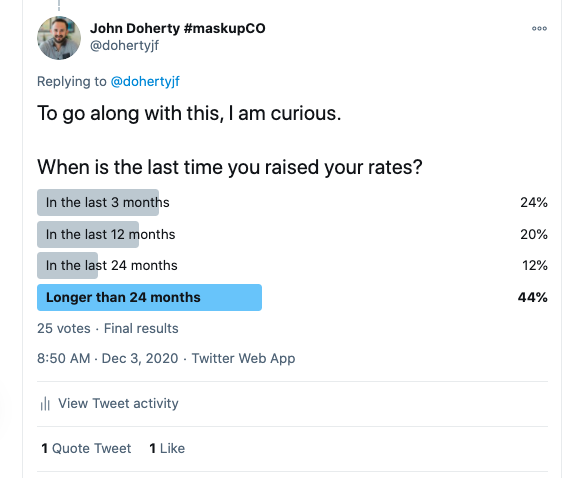I spend a lot of my days thinking about sales and marketing. After all, marketing has been my career for the last decade and I’ve made a good living from it.
For the last five years I’ve been helping agencies (and consultants) get more clients through my company Credo. It’s gone well and been a lot of fun.
One of the eternal challenges with that business, though, is twofold:
- Getting agencies to charge their worth and reasonable rates for the work and value that they do
- Getting prospects to understand the value and what they should expect to pay for it.
Ultimately, this is why I invest a few weeks of time every two years to update Credo’s digital marketing pricing guide. It is rare to get this sort of data in the marketing industry, or at least it was until I published this for the first time in 2017, so it’s become a go-to destination for both sides of the market to benchmark rates and set expectations.
That said, it’s just a start. And regardless of if you’re in the marketing services space or another space, raising rates feels hard to do and scary.
After all, what if no one new agrees to my new pricing and what if my existing clients don’t want to continue on under the new pricing?!?
Cue thoughts of panic and homelessness and maybe even worse – having to get a job working for someone else with two weeks of “paid vacation” each year.
The reality though is that if you’re like 56% of the people who responded to my Twitter poll, you haven’t raised your rates in over a year and because of that you are underpriced.

But never fear dear freelancer/consultant/agency owner, because today I’m going to show you an incredibly easy way to raise your rates.
Before we get to the strategy and tactics, let’s talk about your mindset as it relates to pricing because that is most likely the thing that is holding you back from actually doing it and being successful with it.
Mindset
Raising your prices is not rocket science nor does it have to be scary. But to do it, you have to be in the right mindset. As I’ve dug into my own psychology and that of others over the last few years, I’ve really studied what keeps people from being successful or even just achieving the things they want to in life. That second part is especially apt if the term “successful” triggers you like it does to some people.
Here’s the deal though – you’re never going to hit your goals or achieve your dreams if you don’t believe that you deserve it. If your skills are worth $150 an hour and you’re charging $75 an hour, it will take you at least twice as long to achieve your goals.
I want to tell you a few truths about raising your prices:
- You are not being greedy by raising your rates if clients and prospects are happy to pay it and you’re getting them better results.
- Making your service “affordable to more” is rarely the right move. It may sound good to others on the internet, but it’s going to be much harder to pay your bills and get all of your clients success.
- If you do not raise your prices, I fundamentally believe you are doing your clients a disservice because you are forced to bring on more clients just to make ends meet which means you spend less time focused on each client. Inevitably, work quality suffers. Always.
Some disagree with me, but I believe that pricing is fundamentally a competitive advantage. But my twist is that it can be a competitive advantage both ways.
If you charge less than your competitors, you will likely win more deals. But you’ll also be winning more deals at lower prices, which means you have to bring on more bodies and more clients to achieve the same level of business. I always ask which you’d rather have – 100 clients and you’re making $100,000 a month, or 50 clients and making $100,000 per month.
Personally, I take the latter.
Pricing above the market can be a competitive advantage as well. Sure you may “lose” some lower value deals to others, but the ones who do sign in spite of or even because of your higher pricing will usually appreciate your work even more and likely have even more budget to unlock in the future. It is true that sometimes they’ll have more realistic expectations (you get what you pay for), but if your pricing is where it should be then this shouldn’t be a problem especially if you are good at setting expectations.
Fundamentally, I believe this about pricing:
By charging fair market rates, you are able to attract and get better results for your clients than if you charge below market rates. Your business will be more sane, your team will be happier, and overall your business will be healthier than if you undercharge.
Inflation
Two things service businesses don’t talk about enough (because most service businesses are owned by Technicians as defined by The E-Myth) are business and economics. We do ourselves a disservice by not understanding business theory and economic practices.
One concept we all as business owners need to understand is inflation. In most countries, cost of living and goods increase by ~3% per year.
This means that if you’re not raising your prices by at least 3% per year, it is costing you more to deliver the same services which inevitably leads to lower profit margins and worse results for your clients.
Inflation means your service gets worse through no fault of your own, other than not raising your prices.
How to raise your service business / agency / freelance rates
Alright, so now that we’ve covered mindset and why you need to raise your prices yesterday, let’s talk about how to actually do that.
I also want to clarify that raising your prices is different from initially setting your prices. I wrote about that over here.
How to raise your prices
My strategy for raising prices is simple. It involves the following steps:
- Review that what you are selling is the highest value thing you can be selling, and is in line with what they want to buy.
- If not, fix that. If so, then continue.
As established above, most service business pricing is in some way based on an hourly rate. Whether you price through hourly cost plus pricing, cost plus pricing, or value pricing you still have minimum costs of time (based off salary). If you pay yourself (or someone else) $120,000 per year and they get 4 weeks per year off and you assume a 40 hour work week the other weeks, they cost you $62.50 just to have around. To make them profitable, you have to bill them out at ~$180/hr (their hourly x 3 to account for overhead and other costs).
To raise your prices is simple. You simply calculate your client’s rate off of a higher rate.
The way I do it is this:
- Make sure you are currently tracking your sales metrics. How many leads? How many calls? How many proposals? How many closes? What’s the average budget size? If you don’t have these numbers, get them.
- Once you have those metrics, you have your benchmark.
- Now the next time you go to pitch a project, take your current rate and add 10%.
- That’s it. Add 10%. If you’re scared, then do 5%. If you’d previously quote the project at $2,000 per month, add $200 and make it $2,200. But this is the key – don’t add in anything new. Just quote them an additional $200 per month.
That’s it, seriously. Just quote the very next project 10% more than you did the one before that.
Now, how you do this matters and will determine the success.
A story.
A few years ago we were trialing a new way to improve our metrics on Credo, which meant taking a deposit on a project before introducing them to any agencies. We had a few different ways we priced it as we figured out which one balanced the different considerations.
At first it was a slog. It was hard. As I thought about it I realized we were approaching it with prospects as “Well, we just rolled out this thing and so we need you to…”
We were basically apologizing and telling them that prices were now higher through no fault of their own (which, while true, is not what you want to communicate).
So we started presenting it as this is how things work here. No context, no apologizing.
Because, after all, that was how it worked. That was our pricing for them. They didn’t need to know what others paid/are paying.
And that is exactly how you need to approach it.
Don’t tell them what you quoted the last person. They’ll want that price, and that is no longer your price.
Your price is the new price. That’s their price.
Do this for the next 3-4 proposals to learn the objections and the differences in pitching this size project. But I’ll tell you now that you probably will not see a difference in close rates until you approach at least 30% and likely closer to 50% more than you’re currently charging.
Now go back and repeat steps 1-4. Solidify your numbers, raise your rates, keep doing it.
Hope that helps.
